Drag the appropriate labels to their respective targets.
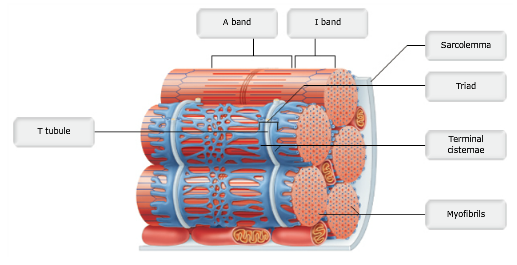
Action potential propagation in a skeletal muscle fiber ceases when acetylcholine is removed from the synaptic cleft. Which of the following mechanisms ensures a rapid and efficient removal of acetylcholine?
Acetylcholine is degraded by acetylcholinesterase.
The neuromuscular junction is a well-studied example of a chemical synapse. Which of the following statements describes a critical event that occurs at the neuromuscular junction?
Acetylcholine is released by axon terminals of the motor neuron.
Action potentials travel the length of the axons of motor neurons to the axon terminals. These motor neurons __________.
extend from the brain or spinal cord to the sarcolemma of a skeletal muscle fiber
Calcium entry into the axon terminal triggers which of the following events?
Synaptic vesicles fuse to the plasma membrane of the axon terminal and release acetylcholine.
Acetylcholine binds to its receptor in the sarcolemma and triggers __________.
the opening of ligand-gated cation channels
Sodium and potassium ions do not diffuse in equal numbers through ligand-gated cation channels. Why?
The inside surface of the sarcolemma is negatively charged compared to the outside surface. Sodium ions diffuse inward along favorable chemical and electrical gradients.
Excitation-contraction coupling is a series of events that occur after the events of the neuromuscular junction have transpired. The term excitation refers to which step in the process?
Excitation, in this case, refers to the propagation of action potentials along the sarcolemma.
Excitation of the sarcolemma is coupled or linked to the contraction of a skeletal muscle fiber. What specific event initiates the contraction?
Calcium release from the sarcoplasmic reticulum initiates the contraction.
A triad is composed of a T-tubule and two adjacent terminal cisternae of the sarcoplasmic reticulum. How are these components connected?
A series of proteins that control calcium release.
What is name given to the regularly spaced infoldings of the sarcolemma?
transverse or T tubules
Which of the following is most directly responsible for the coupling of excitation to contraction of skeletal muscle fibers?
Calcium ions.
What is the relationship between the number of motor neurons recruited and the number of skeletal muscle fibers innervated?
Typically, hundreds of skeletal muscle fibers are innervated by a single motor neuron.
The cross bridge cycle is a series of molecular events that occur after excitation of the sarcolemma. What is a cross bridge?
A myosin head bound to actin
What structure is the functional unit of contraction in a skeletal muscle fiber?
The sarcomere
Calcium ions couple excitation of a skeletal muscle fiber to contraction of the fiber. Where are calcium ions stored within the fiber?
Calcium ions are stored in the sarcoplasmic reticulum.
After a power stroke, the myosin head must detach from actin before another power stroke can occur. What causes cross bridge detachment?
ATP binds to the myosin head.
How does the myosin head obtain the energy required for activation?
The energy comes from the hydrolysis of ATP.
What specific event triggers the uncovering of the myosin binding site on actin?
Calcium ions bind to troponin and change its shape.
When does cross bridge cycling end?
Cross bridge cycling ends when sufficient calcium has been actively transported back into the sarcoplasmic reticulum to allow calcium to unbind from troponin.
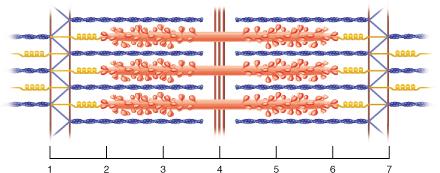
Between which two points would there be substantial amounts of both the proteins actin and myosin?
2 and 3
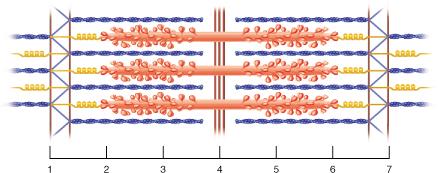
The region between which two points corresponds to the entire A band?
2 and 6
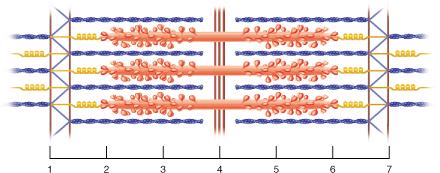
The region between which two points corresponds to the I band?
2 and 3
2 and 5
3 and 5
None of the listed responses is correct.
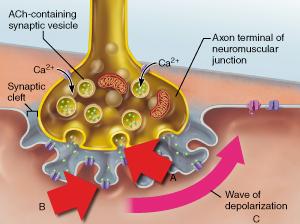
Which event is most significant in initiating the "wave of depolarization" shown in event C?
diffusion of Na+ into the muscle fiber
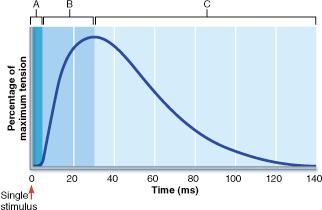
In which phase in the figure would the net movement of Ca2+ into the sarcoplasmic reticulum (SR) be greatest?
C
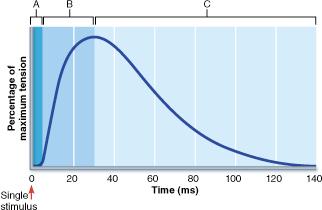
What result would be expected if an additional stimulus, equal in intensity to the first, were to be applied to the muscle at the 60 millisecond (ms) time point?
The muscle would increase in tension to a level greater than that measured at the beginning of phase C.
Excitation-contraction coupling includes all EXCEPT which of the following events?
release of acetylcholine from axon terminals at the neuromuscular junction
Which of the following factors influence the velocity and duration of muscle contraction?
load placed on the muscle
The strongest muscle contractions are normally achieved by ________.
increasing the stimulation up to the maximal stimulus
Which of the following is not a role of ionic calcium in muscle contraction?
activates epinephrine released from adrenal gland
What is the most distinguishing characteristic of muscle tissue?
the ability to transform chemical energy into mechanical energy
Hypothetically, if a muscle were stretched to the point where thick and thin filaments no longer overlapped, ________.
no muscle tension could be generated
The thin filaments (actin) contain a polypeptide subunit G actin that bears active sites for myosin attachment.
True
Eccentric contractions are more forceful than concentric contractions.
True
Muscle cells store more creatine phosphate than ATP resulting in the muscle having a reserve source of energy.
True
Muscle tone is the small amount of tautness or tension in the muscle due to weak, involuntary contractions of its motor units.
True
Binding of calcium to calmodulin is a step in excitation-contraction coupling of ________ cells.
smooth muscle
A motor neuron and all the muscle cells that it stimulates are referred to as a motor end plate.
False
Once a motor neuron has fired, all the muscle fibers in a muscle contract.
False
Which of the following is CORRECTLY paired?
skeletal muscle: voluntary control
In an isotonic contraction, the muscle ________.
changes in length and moves the "load"
An increase in the calcium ion level in the sarcoplasm starts the sliding of the thin filaments. When the level of calcium ions declines, sliding stops.
True
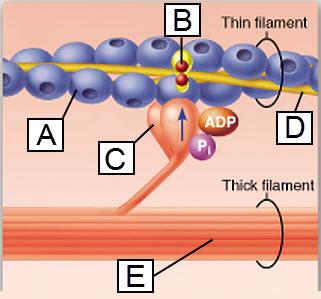
Which lettered protein functions as a motor protein?
C
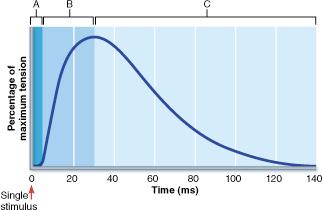
In which phase of the muscle twitch shown in the above figure would the maximum amount of ATP be consumed by myosin head groups?
B
Peristalsis is characteristic of smooth muscle.
True
What structure in skeletal muscle cells functions in calcium storage?
sarcoplasmic reticulum
The distance between Z discs ________ during muscle contraction.
decreases
Thick myofilaments are made of ________.
myosin
Which type of muscle CANNOT contract without being stimulated by the nervous system?
skeletal
Slow oxidative muscle fibers are best suited for ________.
running a marathon
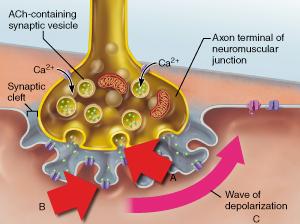
What event directly triggers the release of neurotransmitter shown in A?
diffusion of Ca2+ into the axonal terminus
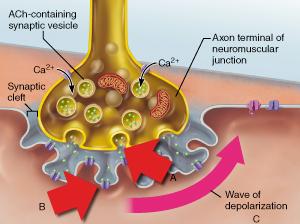
What specific neurotransmitter is released from the axonal terminus as shown in A?
acetylcholine
Three discrete types of muscle fibers are identified on the basis of their size, speed, and endurance. Which of the following athletic endeavors best represents the use of red fibers?
a long, relaxing swim
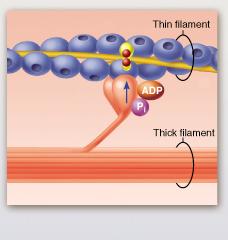
The protein troponin is shown in this figure to be bound to which substance?
calcium ion
The smallest contractile unit of a muscle fiber is ________.
the sarcomere
The muscle cell membrane is called the ________.
sarcolemma
A resting potential is caused by a difference in the concentration of certain ions inside and outside the cell.
True
What is a cross bridge cycle?
It is the cycle in which an energized myosin head binds to actin and performs a power stroke, then binds to ATP in order to detach and re-energize.
An anaerobic metabolic pathway that results in the production of two net ATPs per glucose plus two pyruvic acid molecules is ________.
glycolysis
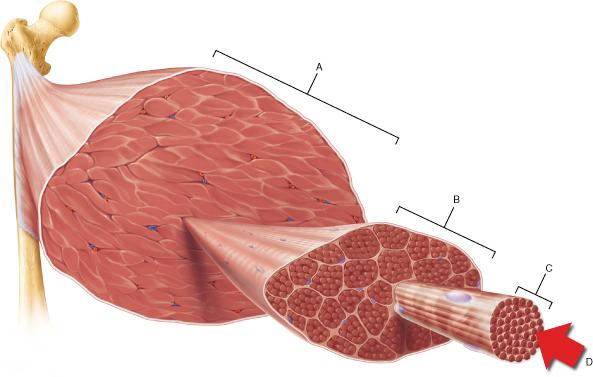
The connective tissue that covers structure A is continuous with which of the following?
tendon
The force of a muscle contraction is NOT affected by __________.
the amount of ATP stored in the muscle cells
Muscle tone is ________.
a state of sustained partial contraction
The response of a motor unit to a single action potential of its motor neuron is called ________.
a muscle twitch
The oxygen-binding protein found in muscle cells is ________.
myoglobin
Immediately following the arrival of the stimulus at a skeletal muscle cell there is a short period called the ________ period during which the neurotransmitter is released by exocytosis, diffuses across the synaptic cleft, and binds to its receptors.
latent
Which organelle contains the contractile elements found in skeletal muscle?
myofibril
What is the role of tropomyosin in skeletal muscles?
Tropomyosin serves as a contraction inhibitor by blocking the myosin binding sites on the actin molecules.
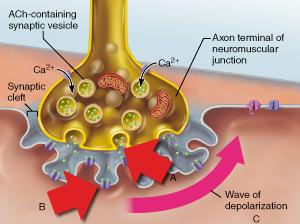
Which statement accurately describes the event indicated by B?
Binding of acetylcholine to a receptor triggers the opening of an ion channel.
Muscle contraction will always promote movement of body parts regardless of how they are attached.
False
What part of the sarcolemma contains acetylcholine receptors?
motor end plate
During muscle contraction, myosin cross bridges attach to which active sites?
actin filaments
What is the functional unit of a skeletal muscle called?
a sarcomere
After nervous stimulation stops, what prevents ACh in the synaptic cleft from continuing to stimulate contraction?
acetylcholinesterase destroying the ACh
During vigorous exercise, there may be insufficient oxygen available to completely break down pyruvic acid for energy. As a result, the pyruvic acid is converted to ________.
lactic acid
Smooth muscles are able to regenerate throughout life.
True
When muscle cells break down glucose to generate ATP under oxygen deficient conditions, they will form ________.
lactic acid
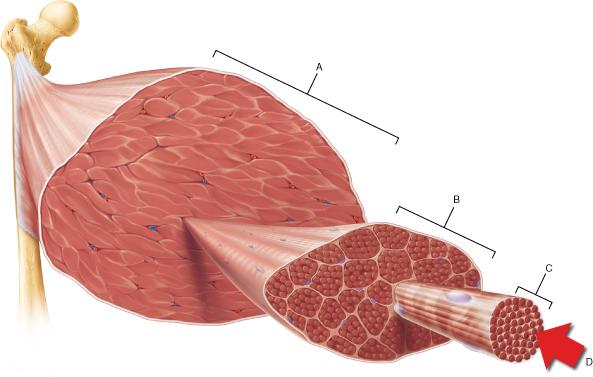
Which structure corresponds to a single fascicle?
B
Most skeletal muscles contain ________.
a mixture of fiber types
A muscle that is lengthening while it produces tension is performing a(an) ________ contraction.
eccentric
The contractile units of skeletal muscles are ________.
myofibrils
Choose the FALSE statement.
Skeletal muscle cells use creatine phosphate instead of ATP to do work.
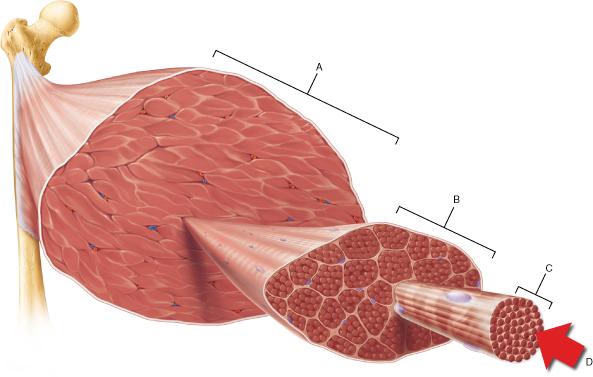
Which of the following is the smallest structural unit in which the distinctive striated bands characteristic of skeletal muscle are observed?
D
What produces the striations of a skeletal muscle cell?
the arrangement of myofilaments
Which protein inhibits interaction between actin and myosin to prevent skeletal muscle contraction; and which ions remove the inhibition?
tropomyosin; calcium ions
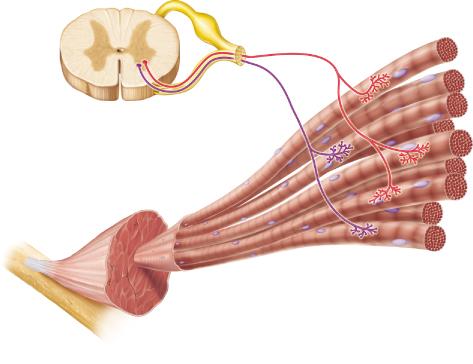
Which of the following describes the neurons shown in this figure?
somatic motor neurons
Which of the following is TRUE?
Skeletal muscle fibers contain sarcomeres; smooth muscle fibers do not.
Which type of muscle CANNOT contract without being stimulated by the nervous system?
skeletal
The sliding filament model of contraction states that ________.
during contraction the thin myofilaments slide past the thick myofilaments so that the actin and myosin myofilaments overlap to a greater degree
The major function of the sarcoplasmic reticulum in muscle contraction is to ________.
regulate intracellular calcium concentration
The force of a muscle contraction is NOT affected by __________.
the amount of ATP stored in the muscle cells
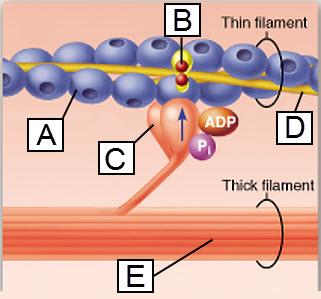
The protein actin is indicated by which letter?
A
Muscle tissue has all of the following properties except ________.
secretion
In an isotonic contraction, the muscle ________.
changes in length and moves the "load"
Which of the following surrounds the individual muscle cell?
endomysium
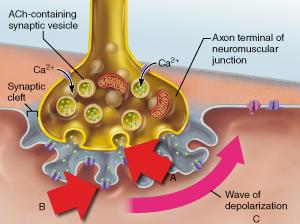
What event directly triggers the release of neurotransmitter shown in A?
diffusion of Ca2+ into the axonal terminus
What is the functional unit of a skeletal muscle called?
a sarcomere
The contractile units of skeletal muscles are ________.
myofibrils
The smallest contractile unit of a muscle fiber is ________.
the sarcomere
The first step toward generating a skeletal muscle contraction is ________.
stimulation of the muscle by a nerve ending
Which organelle contains the contractile elements found in skeletal muscle?
myofibril
Most skeletal muscles contain ________.
a mixture of fiber types
The term aponeurosis refers to ________.
a sheetlike indirect attachment to a skeletal element
Muscle tissue does NOT ________.
produce blood cells
What special feature of smooth muscle allows it to stretch without immediately resulting in a strong contraction?
stress-relaxation response
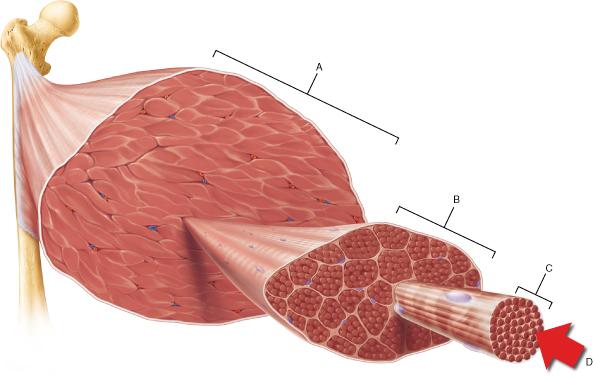
In the figure above, which structure corresponds to a single skeletal muscle cell?
C
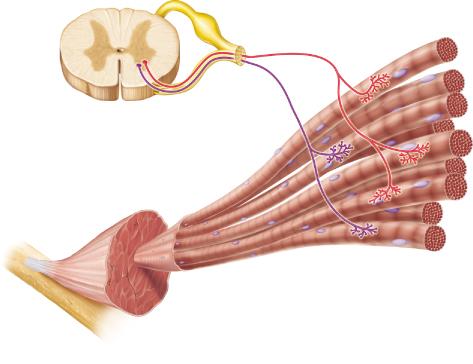
If both of the neurons in the figure were activated, more muscle fibers would contract than if either neuron alone were active. This mechanism for control of the force of muscle contraction is known as ______.
recruitment
The sliding filament model of contraction involves ________.
actin and myosin sliding past each other and partially overlapping
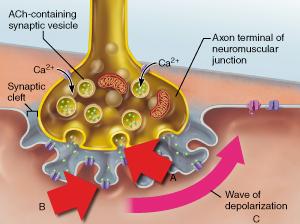
Which statement accurately describes the event indicated by B?
Binding of acetylcholine to a receptor triggers the opening of an ion channel.
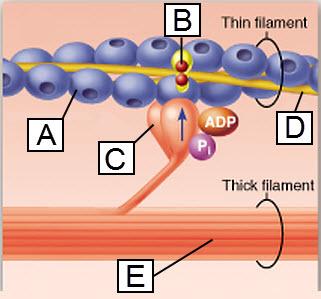
Which lettered protein functions as a motor protein?
C
Immediately following the arrival of the stimulus at a skeletal muscle cell there is a short period called the ________ period during which the neurotransmitter is released by exocytosis, diffuses across the synaptic cleft, and binds to its receptors.
latent
A muscle that is lengthening while it produces tension is performing a(an) ________ contraction.
eccentric
Choose the FALSE statement.
Skeletal muscle cells use creatine phosphate instead of ATP to do work.
Which protein inhibits interaction between actin and myosin to prevent skeletal muscle contraction; and which ions remove the inhibition?
tropomyosin; calcium ions
Which muscle characteristic describes the ability of muscle to respond to a stimulus?
excitability
Binding of calcium to calmodulin is a step in excitation-contraction coupling of ________ cells.
smooth muscle
The oxygen-binding protein found in muscle cells is ________.
myoglobin
One of the important functions of skeletal muscle contraction is production of heat.
True
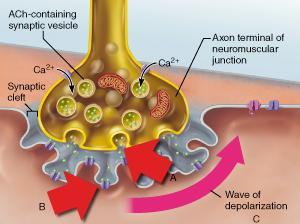
What specific neurotransmitter is released from the axonal terminus as shown in A?
acetylcholine
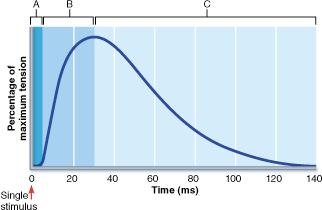
In which phase of the muscle twitch shown in the above figure would the maximum amount of ATP be consumed by myosin head groups?
B
What structure in skeletal muscle cells functions in calcium storage?
sarcoplasmic reticulum
Muscle contraction will always promote movement of body parts regardless of how they are attached.
False
Slow oxidative muscle fibers are best suited for ________.
running a marathon
What is the functional role of the T tubules?
enhance cellular communication during muscle contraction
The force of muscle contraction is controlled by multiple motor unit summation or recruitment.
True
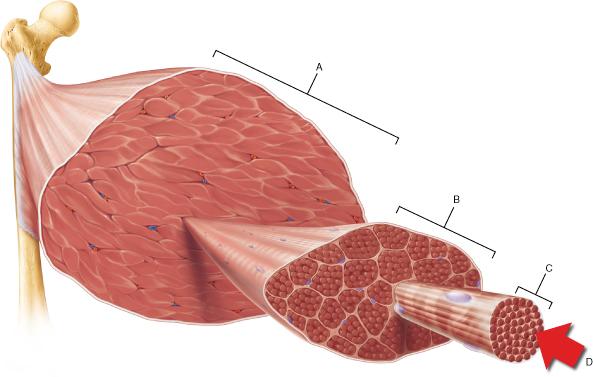
Which of the following is the smallest structural unit in which the distinctive striated bands characteristic of skeletal muscle are observed?
D
A contraction in which the muscle does not shorten but its tension increases is called isometric contraction.
True
The connective tissue sheaths of skeletal muscle, in order from internal to external, are the ________.
endomysium, perimysium, and epimysium
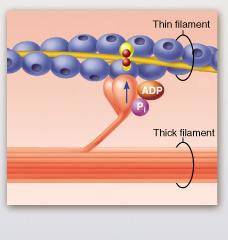
The protein troponin is shown in this figure to be bound to which substance?
calcium ion
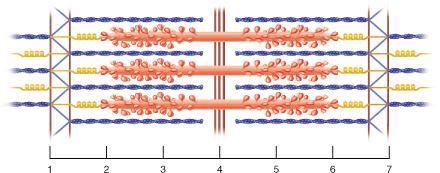
The smallest contractile unit within skeletal muscle would correspond to the distance between which two points in the figure?
1 and 7

Which of the following describes the neurons shown in this figure?
somatic motor neurons
An increase in the calcium ion level in the sarcoplasm starts the sliding of the thin filaments. When the level of calcium ions declines, sliding stops.
True
Which muscle cells have the greatest ability to regenerate?
smooth
Once a motor neuron has fired, all the muscle fibers in a muscle contract.
False
The distance between Z discs ________ during muscle contraction.
decreases
Creatine phosphate functions in the muscle cell by ________.
storing energy that will be transferred to ADP to resynthesize ATP
What is the role of tropomyosin in skeletal muscles?
Tropomyosin serves as a contraction inhibitor by blocking the myosin binding sites on the actin molecules.